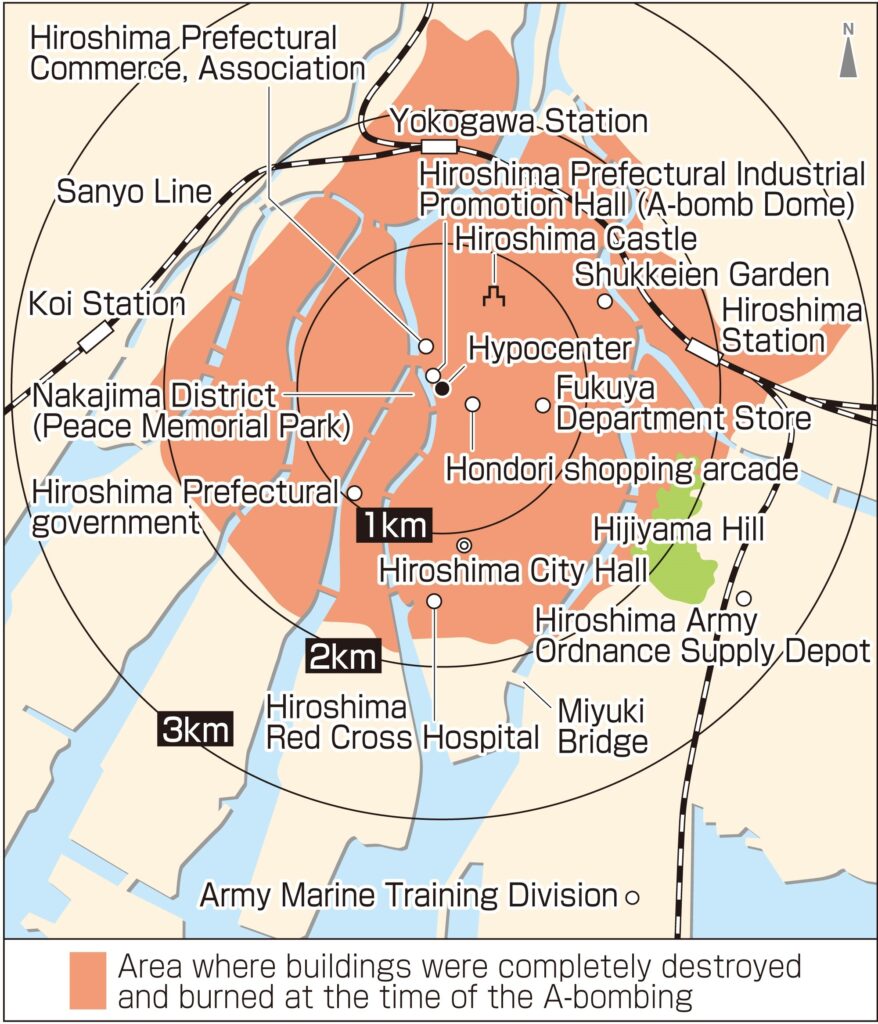Damage from the blast, thermal rays, and radiation
The atomic bomb dropped by the U.S. military on Hiroshima exploded 600 meters in the sky nearly directly above the city center, causing damage that extended throughout Hiroshima in a concentric pattern.
At the instant of explosion, air pressure at the point of detonation rose to as high as several hundreds of thousands of atmospheres, rapidly expanding the surrounding air and generating a powerful shock wave akin to a wall of air. Within a two-kilometer radius of the hypocenter, most wooden structures collapsed. Many people in the area were trapped and crushed to death under the destroyed buildings.
The surface temperature of the fireball generated by the detonation rose to 7,700 degrees Celsius within about 0.2 seconds, and the ground-surface temperature around the hypocenter reached between 3,000 and 4,000 degrees. Those who were directly exposed to the thermal rays within 1.2 kilometers of the hypocenter suffered severe physical injury including to internal tissues. Most died instantly or within a few days after the atomic bombing.
The atomic bombing’s thermal rays first caused fires in structures in the center of the city and then triggered conflagrations throughout the city due to fires that were being used at the time and other sources. Within a two-kilometer radius of the hypocenter nearly everything was incinerated. Around 92 percent of the roughly 76,000 structures in the city were at least half-destroyed and half-burned.
The huge amounts of radiation emitted by the atomic bombing destroyed the cells of those who were exposed, causing severe damage to a variety of tissues in which active cell division takes place, including blood-producing bone marrow and lymph nodes. In some cases, those with no external injuries or who had entered Hiroshima soon after the bombing died after suffering continued symptoms such as high fever, diarrhea, hair loss, and purple spotting of the skin (subcutaneous hemorrhaging). Those symptoms, which persisted until the end of December 1945, are known to be acute effects from radiation exposure.
Long-term effects caused by radiation from the atomic bombing arose with the passage of time. The number of patients with leukemia, one of the most common aftereffects, began to increase around two or three years later and peaked around seven or eight years after the bombing. Other cancers are thought to have increased starting around five to ten years after the bombing.

Death toll-Precise number of deaths still unknown
At the time of the atomic bombing, around 350,000 people are thought to have been in Hiroshima. That population included residents, military personnel, and those who had been mobilized from neighboring towns and villages for the work of demolishing buildings to create fire lanes.
In addition to many Koreans, people from Taiwan and mainland China also lived in the city. Some were there because they had been conscripted as laborers or into military service. Japanese-Americans, international exchange students from Southeast Asia and China, German priests, Russian families, and American soldiers captured as prisoners of war were also in Hiroshima at the time.
In 1976, the Hiroshima City government reported to the United Nations that the estimated number of deaths from the atomic bombing had been 140,000 people (with a margin of error of ± 10,000) by the end of December 1945. However, confirmation of the exact number of victims was difficult, with many bodies left unidentified, corpses swept away in rivers, and local government agencies in charge of such work destroyed. With such extensive devastation, the exact number of people killed in the bombing remains uncertain even today.
(Source: Hiroshima Peace Memorial Museum Collection Catalogue-Carrying the Legacy of Hiroshima [2020])